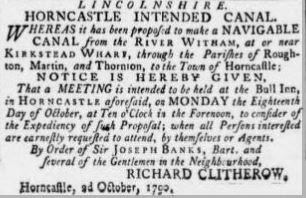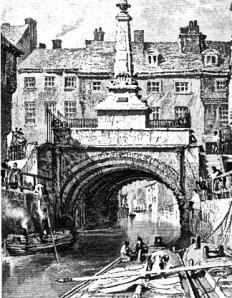The canal was reputedly used by the Danes when they invaded England and by the Normans to carry stone to build Lincoln Cathedral in the 11th century.
But the earliest mention of the canal is in the year 1121, in Symeon of Durham's, Historia Regium : "In the same year, king Henry cut a large canal from Torksey to Lincoln, and by causing the River Trent to flow into it, he made it navigable for vessels." The absence of any other documentary evidence indicates that the Canal was built during the reign of Henry I.
The Romans may have built a canal from Torksey to Hardwick, at the centre of a large Roman farm; this canal was probably extended during Henry I's reign.
The Foss Dyke enabled Lincoln and the Fens of Lincolnshire to communicate with Gainsborough and Hull, and with the Ouse and York.
Over the centuries the canal went into decline due to lack of maintenance. Katherine Swynford, who lived at Kettlethorpe near to the canal, is credited with having organized a protest to repair it, in 1375. The canal continued to deteriorate, until by the 17th century it was virtually impassable.
"1518, 10 June. A collection begins to be made towards the cleansing and repairing of the Foss-dyke, for which the King has sent down his commission. [The work was found to involve more cost than it proved easy to discharge, and on 14 Dec. it is reported that the Bishop of Lincoln had issued a commission to all curates and others in his diocese for aid, and granted pardon to all them that helped in the same, and collectors are appointed in consequence to ride to divers towns. Collections continued to be made for a long time, including York and Hull in their range.]"
"1571 24 March Where[as] within the county of Lincoln, timber, wood, coal, turf and other necessaries have been almost clearly felled, taken away, consumed and spent by many greedy persons, owners of the same since the dissolution of the late religious houses, to the great decay of the poor ancient city of Lincoln, formerly served out of the said county with these necessaries for the relief of the said city and for setting the poor people on work; and for that there is yet some plenty of timber, &c. within the counties of Nottingham, Derby and York next adjoining, whence the said poor city could be well served if the same could be brought by water; [it is desired] that an Act of Parliament may be made for a commission to assess all persons within seven miles of the city for the dyking, cleansing and scouring of Foss-dyke, in order that sufficient water may be brought from the Trent to bring the said timber, etc." - The corporation of Lincoln: Registers, vol. IV (1564-99)
King James I transferred ownership of the canal to the Corporation of Lincoln.
In 1671, during the reign of Charles II, Lincoln obtained an Act which authorised improvements from Boston to the Trent. Work was carried out on the Fossdyke, but only the first 100 yards (91 m) of the Witham, from Brayford Pool to High Bridge, received attention. The work was carried out by Samuel Fortrey, a man with previous experience of draining the fens. He was required to bear some of the cost himself, in exchange for some of the profits. The work was completed in 1672, and included a navigable sluice or lock at Torksey, which had first been proposed by Simon Hill in 1632. Warehouses and wharves were built at Brayford Pool.
1685 July 21.—Whereas for these several years now last past it hath been a custom in this city for the mayor elect and the two sheriffs elect severally to make and give a treat or banqueting on every Holy Rood day, being Sept. 14, presently after they were elected, and the said treat or banquetting not only being a great trouble and charge, and several abuses and misdemeanours committed on that day by the freemen and inhabitants and the great number of foreigners which constantly resort to the said treat, to the great disturbance of the King's peace and abuse of the said treat; and for that the said treat or banquetting upon serious consideration is looked upon to be a thing altogether unnecessary and useless; therefore it is hereby ordered that the said treat . . . . shall for the future be clearly laid aside and none made. And the city being much in debt for money borrowed for the Foss dyke and for renewing the charter, 13l 13s. 4d. shall yearly be deducted from the Mayor's allowance of 90l., and 26l. 6s. 8d. from the sheriffs' allowance of 46l. p. 398. - The corporation of Lincoln: Registers, vols VI and VII (1653-1710)
By 1717, passage from Torksey was again difficult. Coal traffic averaged 1,357 tons per year, bound for Lincoln, but tolls were insufficient to finance repairs.
The corporation in 1741 granted a lease of two-thirds of it for 999 years, at a rent of £50 per annum, and of the remaining third, for 99 years, at £25 per annum to Richard Ellison of Thorne, and it was reopened in 1745. Previously to this period coals were sold at twenty one shillings per chaldron ; but when Ellison cleared the canal, and re-opened the river in 1745, they were offered and sold at thirteen shillings. He dredged it to provide 3.5 feet (1.1 m) of depth, and re-opened it in 1744. Two years later, the tolls were £595, and continued to increase. Under his son, the tolls were £2,367 in 1789, while his grandson collected £5,159 in 1811.
"From that time to the present, this long neglected canal has been improving, and the increasing number of vessels daily floating on its surface, renders it an almost inexhaustible mine of wealth to the lessee, an incalculable benefit to the commercial part of the city, and a never failing source of employment to the industrious poor."
- The History of Lincoln; Containing an Account of Its Antiquities - 1825
 |
| 1826 Plan of the Fossdyke Navigation |
The Great Northern Railway negotiated with the proprietors of the Witham and Fossdyke in 1846, to guarantee them an income by leasing the waterways. Richard Ellison IV had agreed a lease for 894 years, at £9,570 per year, based on the average profit for the previous three years plus 5 per cent.
A series of takeovers and mergers resulted in its ownership changing several times, before it was nationalised, and became the responsibility of the British Waterways Board in 1948.
Today the Foss Dyke is a popular pleasure boating canal, boats from Lincoln and Boston can connect with the canals system of England, subject to beam width.
 |
| Today Torksey Lock is a popular mooring for pleasure boates. |








